Cultures > Babylonia
Babylonia

Background
The ancient civilization of Babylonia was based around the Tigris and Euphrates Rivers and had its capital city at Babylon in what is now modern day Iraq. Babylonia was born in the southern portion of Mesopotamia following the collapse of the Akkadian Empire and was contemporary with the growth of Assyria. The civilization existed in three major periods, the Amorite dynasty that featured leaders such as Hammurabi, the Assyrian domination over Babylon and the Neo-Babylonian Empire when the Chaldeans led by Nabopolassar took back Babylon and created their own empire.
Its easy to think simply of just the city of Babylon but in reality there was an entire massive territory that the city controlled. The civilization known as Babylonia while now can be looked at cohesively, was actually the influence and development of slightly different civilizations in the region that conquered both culturally and militarily then eventually mixed to form a sort of unified culture. They were able to develop throughout several thousand years and the civilization as a whole was one of the major influences on the modern day. Overall the entire civilizations of both Assyria and Babylonia are built upon the foundations, traditions and culture that were first set by Sumer and the Akkadian Empire, albeit in an updated format.
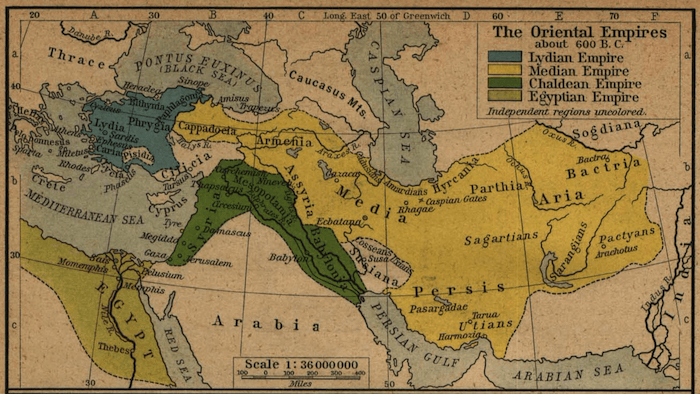
Mesopotamian Empires 600 BC - Historical Atlas (1923)
The Babylonians and Assyrians had many of the same gods as the Sumerians and Akkadians as can be seen on this gods comparison chart. They adopted many of the same traditions and techniques of water mastery, irrigation and canal construction, agriculture and utilized existing trading networks. Garden building and beautiful cities were meant to display mastery over the environment and the kings ability to provide life. Under Babylonian reign the region of Mesopotamia would reach the pinnacle of its power in the ancient world more so than any other previous civilization. This was due to it being the last surviving "king of the hill" before being incorporated and expanded on during the Achaemenid Empire and following the conquest of Alexander the Great who died suddenly and mysteriously in the capital city.

Hanging Gardens of Babylon - 19th Century Engraving
Babylonia is most well known for its capital city which exerted tremendous cultural, intellectual and artistic influences on the rest of the ancient world. The birthplace of many scientific achievements, engineering feats and other discoveries that would impact humanity for centuries, Babylon was also home to many of the worlds ancient wonders. Featuring one three of the Seven Wonders of the Ancient World; the Hanging Gardens of Babylon, the Walls of Babylon with its massive Ishtar Gate, along with other major structures such as the temple of their chief god Marduk known as the Esaggila and the massive towering ziggurat known as Etemenanki or the biblical Tower of Babel, the city of Babylon was quite a sight to see rising up out of the arid and inhospitable desert.
Origins
Before the entire united civilization of Babylonia emerged in 1894 BC there existed unique groups and developments that would characterize the region for years to come. Around 5500 BC the region began to be dominated by the ancient city-states of Sumer. They existed alongside Akkad to the north and occupied cities such as Ur, Uruk, Lagash and Kish. They were an advanced peoples who created one of the first forms of written language called cuneiform.
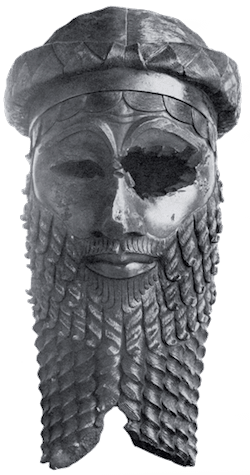
Sargon the Great Bronze Head -
Sumer existed as an independent civilization until it was conquered by the Akkadians and there appears to have been a blending of culture and a unification of the two civilizations for a period of time. As Sumer was taken over by the Akkadians under Sargon the Great (2334-2279 BC) and incorporated into the Akkadian Empire the entire region of Mesopotamia flourished. It was during the rule of Sargon that the city of Babylon was first mentioned.
According to a tablet found during the period of his reign it describes Babylon as simply a small religious city and was not independent from the rest of the Akkadian Empire. When the Akkadian Empire collapsed it fell to form the lesser state of Assyria in the northern portion of Mesopotamia. The southern region of Babylonia was dominated by a group called the Gutium for several decades but they were eventually overthrown and replaced by the Neo-Sumerian Empire. Called the Third Dynasty of Ur, and ruled by the king Ur-Namma the Neo-Sumerian Empire shared borders with growing Assyria and encompassed most of what would soon become ancient Babylonia.
First Dynasty of Babylon
Also known as Old Babylon, the First Dynasty of Babylon, also known as the Amorite Dynasty was founded around 1894 BC by the Amorites and would be a civilization that included many ancient towns such as Old Babylon. Under ruler Hammurabi the city of Babylon would expand and grow significantly and become the major capital city of the new independent civilization of Babylonia. By ousting the Third Dynasty of Ur the Amorites would successfully bring about the end of the Sumerian civilization and establish the second major kingdom that would characterize the the region of Mesopotamia from here on out.

Babylon - Fischer von Erlach (1721)
During this period the Semitic written language of Akkadian was still used for formal and official use, despite the Amorites and future Kassites to not be from Mesopotamia. The ancient Sumerian cuneiform was used for religious purposes but was not spoken as it had become taken over by the Akkadian language. Both Sumerian and Akkadian cultural influences and traditions played a major role in the development of both Babylonia and Assyrian culture even when Babylonia was ruled by foreigners.
Hammurabi
The reign of Hammurabi is debated between scholars who come from two different camps, the middle chronology and the short chronology. Based on middle chronology he ruled from 1792 BC to 1750 BC and based on short chronology he ruled from 1728 BC to 1686 BC. This is based on a difference in interpreting the 56/64-year astronomical calculation that was deduced from the Venus Tablet of Ammisaduqa artifact and the clay document known as tablet 63 or Enuma anu enlil.
It is easy to try and place the dates on the calendar we currently have but going back in time and placing events forces archaeologists to understand an ancient calendar and then find a way to equate it to our modern one. Sometimes there are errors which is why most dates are ranges not specified, its better to generally follow the flow of events and power than the dates.
Code of Hammurabi
Hammurabi was the sixth Amorite king who succeeded his father named Sin-Muballit and was known for bringing order, stability and prosperity to the Amorite dynasty. In fact, under Hammurabi the civilization of Babylonia would grow to become larger than the previous Akkadian Empire or the Neo-Sumerian Empire. However it was to be short lived as after the death of Hammurabi the Babylonia empire quickly fell apart. But the achievements and developments made during this dynasty would reverberate through all of the successive ones, each trying to emulate the success of not only Hammurabi, but Sargon the Great who came before him and whose myth was extremely influential in Assyrian-Babylonian culture.

Hammurabi Drawing -
One of greatest achievements of Hammurabi was the development of his set of laws known as the Code of Hammurabi. They were displayed as a massive stone tablet that would have been available for all to see as it was positioned in a public area.
Sealand Dynasty
Kassite Dynasty
The Kassite Dynasty was a period of rule that encompassed the years 1595 BC to 1155 BC. It was during this time the rest of the ancient world saw the Bronze Age Collapse and the beginning of a 400 year Dark Ages. Babylonia was able to survive being so distant from the eastern shores of the Mediterranean Sea where most of the destruction was centered around. Not only surviving, the Kassite dynasty founded by Gandash of Mari was to be the longest period of political stability in Babylonia's history. Much like their predecessors the Amorites the Kassites were not native to Mesopotamia though.

Egypt & Mesopotamia Map (1450 BC) - Historical Atlas (1923)
The Kassites first appeared in the Zagros Mountains in what is now north-western Iran. Their language was not-semitic and they were thought to have either developed an independent language or evolved from a related Asia minor language. It is unclear about the true origins of the Kassites. Regardless, Babylon remained the capital of Babylonia despite the civilization not having a ton of power under Kassite rule.
Second Dynasty of Isin
Period of Chaos
Between the years of 1026 BC and 911 BC There was was a great period of political instability that wrecked Babylon and threw it into an anarchic state. This was caused by the invading Arameans who decided to sack Babylon in 1026 BC. Despite conquering the city no king was able to claim power over the civilization for nearly 20 years and even when the first one did it took several years to stem the tide of instability. These conditions led Babylon to be conquered by the Assyrians led by Ashur-nirari IV in 1018 BC and occupied briefly.
There rose an independent state in southern Babylonia at this time called Dynasty V that lasted from 1025 BC to 1004 BC. This breakaway faction was led by the Kassite clan leader named Simbar-shipak. Another Dynasty VI replaced the previous one and managed to let the Kassites rule again from 1003 BC to 984 BC. It appears during this period they were able to bring Babylon itself back under Kassite rule.
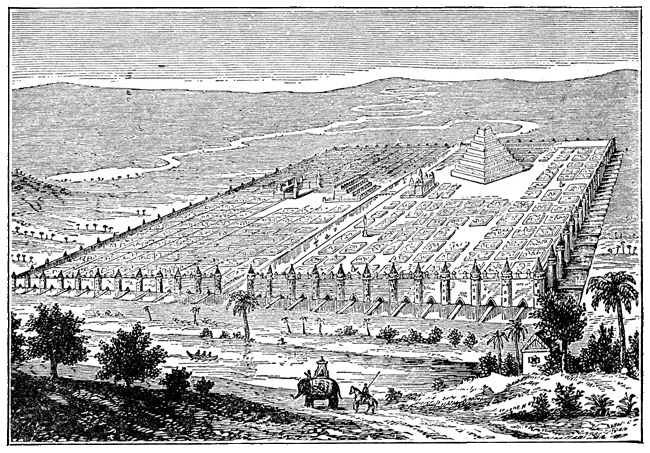
City of Babylon Drawing
However, soon the last remnants of the Kassite dynasty were destroyed by invading Elamites who founded the Dynasty VII (984-977 BC) but they were eventually deposed as well. Once again the Arameans decided to sack Babylonia and rule was taken by a native Babylonian named Nabu-muki-apli in 977 BC. This began the period known as Dynasty VIII. Dynasty VIII was replaced by Dynasty IX in 941 BC and leader Ninurta-kudurri-usur II took power.
Babylon was very weak during this period as it was just beginning to regain its footing as a civilization. There were still many territories under foreign control of groups such as the Arameans and the Suteans. By 850 BC the first mentions of the groups called the Chaldeans and the Arabs appear. They arrived on the scene and they had established their own territory in south-east Babylonia. This was an extremely infertile and hostile part of Babylonia but allowed them to first establish a foothold in the region. It is unknown where the Chaldeans originally came from either.
Neo-Assyrian Empire
Babylonia and the city of Babylon under the leadership of Shamash-mudammiq were conquered by the Assyrians under Adad Nirari II in 911 BC and the civilization was annexed into the Neo-Assyrian Empire. Babylonia despite a revolution under the leader Sennacherib would remain under Assyrian control until the collapse of the civilization and violent take over by Nabopolassar and his coalition.

Ancient Babylon Drawing
Adad Nirari II would cement his power over Babylon in a peaceful manner through diplomatic marriages and do not subjugate the people to any kind of harsh treatment. While not originally taking all of Babylonia at once, the further reigns of Nabu-shuma-ukin I, Tukulti-Ninurta II, Ashur-nasir-pal II would increasingly bring more and more territory under Assyrian control. Under the reign of the Assyrian king Shalmeneser III sacked the city of Babylon and slew its vassal king Nabu-apla-iddin and managed to subjugate all of the various tribes living throughout the region such as the Arameans, Suteans and Chaldeans.
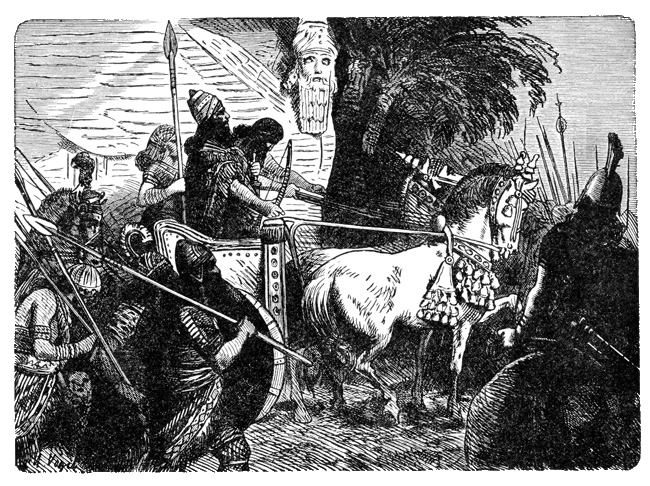
Soldiers of Assyria Going to Battle
Following the Assyrian conquest of Babylonia they installed the vassal king Marduk-zakir-shumi I (855–819 BC) who was succeeded in rule by Marduk-balassu-iqbi (819–813 BC) and eventually by Baba-aha-iddina. When Shalmeneser III died the rule over Babylonia passed to the regent the mythological queen Semiramis also known as Shammuramat who was holding the throne for the young king Adad Nirari III.
Baba-aha-iddina was eventually killed by Adad Nirari III who assumed control over Babylon personally. He was succeeded by Ninurta-apla X who may have the longest single name lineage in 800 BC but was also subjugated by Assyria. The next ruler of Babylonia Marduk-bel-zeri would also be ruled by the Assyrian king Shamshi Adad V who still made Babylonia a vassal state.
Chaldeans
During the period of civil war under the reign of Shamshi Adad V, a Chaldean man named Marduk-apla-usur seized the throne in 780 BC. The Chaldeans were a group of people of unknown origin who about a century before settled in the southern and inhospitable part of the Tigris and Euphrates valley near the Persian Gulf.
However, Shamshi Adad V was successful in putting down the civil war with his brother over the throne and he set his sights on reclaiming Babylon. Eventually subduing Babylon he allowed Marduk-apla-usur to remain on the throne. Marduk-apla-usur was succeeded by Eriba-Marduk in 769 BC and by his son Nabu-shuma-ishkun in 761 BC. However, rule was not stable and there was much social and political chaos throughout Babylonia.
The Chaldeans were eventually overthrown by Nabonassar in 748 BC who managed to reassert control over Babylonia and brought stability to the civilization. His reign and power was not contended by the Assyrian king to the north named Ashur-nirari V. This is because Assyrian was undergoing a period of decline which had been harmful to its military so it could not afford to engage in conquest.
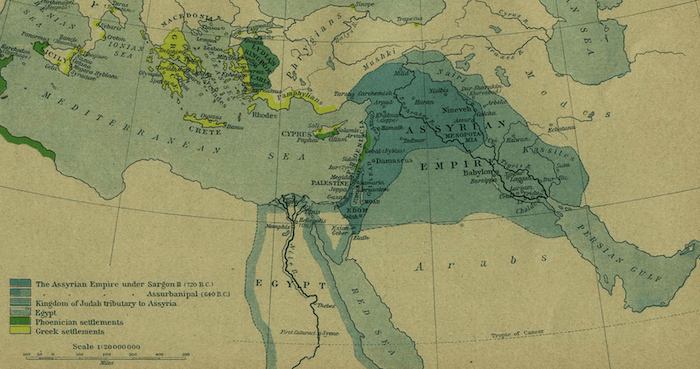
Assyrian Empire Map (750-625 BC) - Historical Atlas (1923)
However, under the rule of Tiglath-Pileser III (745-727 BC), Assyrian launched an invasion of Babylonia. Successfully subduing the city, Nabonassar was allowed to continue his rule as a vassal king that paid tribute to the north. His successors Nabu-nadin-zeri, Nabu-suma-ukin II, Nabu-mukin-zeri were all also subjugated by Tiglath-Pileser III. In 729 BC though the Assyrian king chose to rule from the city of Babylon and dispensed with the vassal kings for the first time in two hundred years. It was during this time that the easier to use Aramaic language was made the official language of the empire, with the Akkadian language and cuneiform only used by scholars and religious officials.
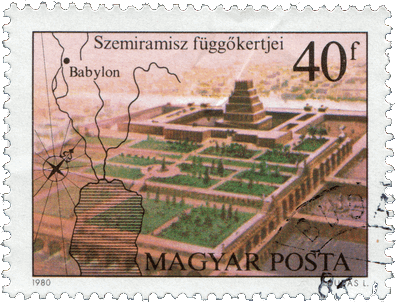
Babylon Stamp - (1980's)
Tiglath-Pileser III was succeeded by Shalmaneser V (727-722 BC) who ruled from Babylon and more or less followed the same policies as Tiglath. He would die suddenly while trying to take the city of Samaria and would be succeeded by Sargon II who may have been an illegitimate ruler and usurper to Assyrian throne. Regardless, Sargon II was a competent and effective ruler who would father the dynasty of Neo-Assyrian Great Kings.
The Babylonians revolted upon the death of Shalmaneser V and a new group of Chaldeans led by Marduk-apla-iddina II (721-710 BC) managed to seize the throne in Babylon backed by the civilization of Elam. They were successfully able to avoid Assyrian repercussions from this because Sargon II had been forced to take the Assyrian military to defend Media and defend the civilization from a combined Scythian and Cimmerians invasion. Sargon was successful in doing so and upon his return to Mesopotamia he invaded Babylon and deposed the Chaldean ruler. Marduk-apla-iddina II fled for his life to Elam while Sargon claimed dominance over Babylon.
Sennacherib
Control over Babylon would continue through the early reign of Sennacherib who installed his son Ashur-nadin-shumi as king of Babylon. Marduk-apla-iddina II would attempt to try and reclaim the throne with the assistance of Elam but would be unsuccessful. The Assyrian prince would later be murdered by an Elamite named Nergal-ushezib who assumed the throne of Babylonia for a short period of time. However, Sennacherib vowed to avenge the death of his son and he invaded Babylon and Elam and utterly destroyed the entire city. He scattered the bricks among the desert and the old city of Babylon was lost to history.
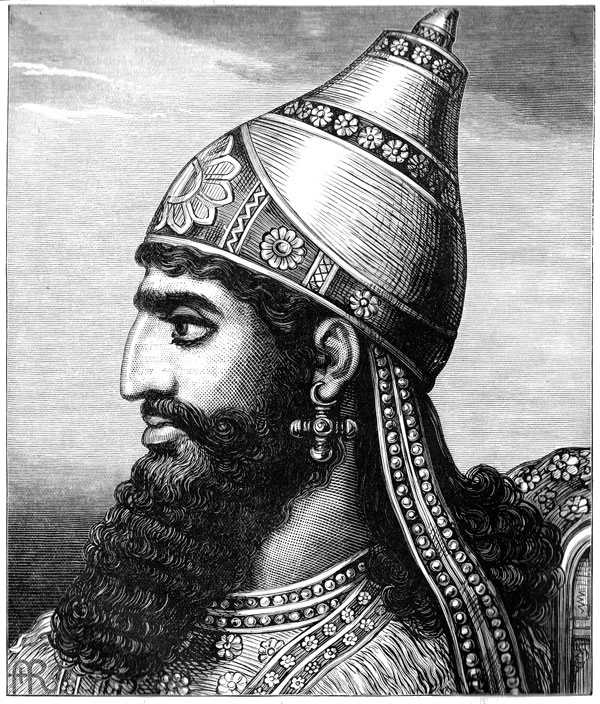
Sennacherib Drawing -
Sennacherib would later be murdered by his sons who tried to seize the throne from the rightful heir Esarhaddon who was forced to return home from exile, put down the rebellion and stabilize Assyria. Successfully doing so he executed all of the rebels and their families and immediately set to work on rebuilding Babylon. He installed the puppet king Marduk-zakir-shumi II who was later deposed in yet another attempt by Marduk-apla-iddina II to seize the throne.
Esarhaddon
Esarhaddon (681–669 BC) would be forced to invade Babylonia to oust Marduk-apla-iddina II, sending him fleeing once again back to Elam where he would later die in exile. In response to all the social turmoil Esarhaddon decided to rule from Babylon which brought great prosperity to the city and laid the foundations for what would later become the Neo-Babylonian Empire. He rebuilt the streets and cities, the temples and palaces and was able to expand the territory of Assyria to some of its greatest heights.
In choosing his successors he decided to place his oldest son Shamash-shum-ukin in charge of Babylon and his youngest son Ashurbanipal in charge of the entirety of Assyria based out of the capital at Nineveh. This relationship worked out well between the two brothers for many decades before eventually Shamash-shum-ukin decided he wanted to rule over his own independent kingdom in the south and declared Babylon the seat of a great Empire.
Ashurbanipal
Ashurbanipal could not allow this to happen so he invaded the city of Babylon following an armed revolt by his brother and his allied coalition of Elamites, Achaemenids, Medians, Suteans, Phoenicians, Arabs, Arameans and Chaldeans. Despite facing this overwhelming group of people who had been tired of being vassal states to Assyria, Babylon was eventually taken by Ashurbanipal. Shamash-shum-ukin was killed during the conflict and Ashurbaniapal went on to sack and destroy the civilization of Elam once and for all.
Regarding the rebelling tribes he violently subjugated them and the Assyrians were exceptionally brutal towards them. This event would play no small part in the larger revolution to come following the death of Ashurbanipal. Following the successful capture of Babylon an Assyrian governor named Kandalanu was installed as the ruler until 627 BC.
Revolt of Babylon
When Ashurbanipal died he was replaced by his son Ashur-etil-ilani. However, during this period Assyria descended into chaos and civil war with many factions competing for the throne. Ashur-etil-ilani was removed from his throne by his general named Sin-shumu-lishir in 623 BC who also ruled over Babylon. After only one year of rule has also removed and was replaced by Sin-shar-ishkun. Civil war still plagued the land and this was to be the death knell for the Assyrian Empire.
During this time all of the tribes that were brutally subjugated by Ashurbanipal allied together under a Chaldean named Nabopolassar and a Mede named Cyaxares who launched a combined assault of the Assyrian capital city and other important regional centers.
Neo-Babylonian Empire
Toffteen. O (1907). Notes on Assyrian and Babylonian Geography. The American Journal of Semitic Languages and LiteraturesVol. 23, No. 4 (Jul., 1907), pp. 323-357.